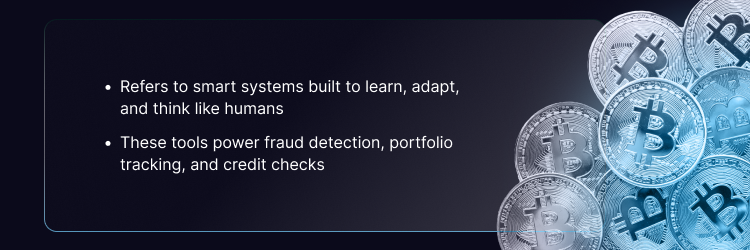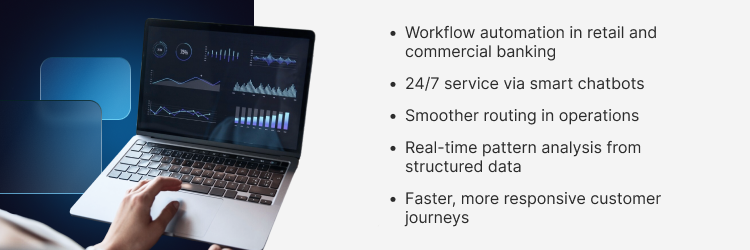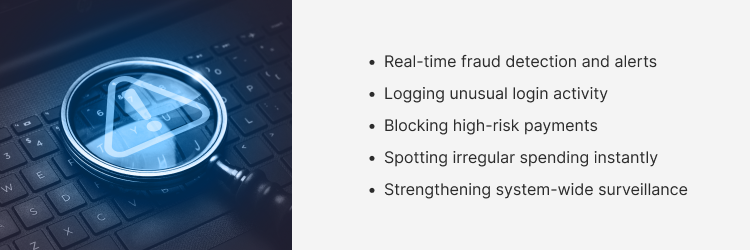
The pressure to move faster, stay accurate, and make smarter choices has pushed financial institutions to rethink everything. Enter artificial intelligence — the new power player in banking, trading, fraud detection, and customer service.
According to Grand View Research, the global value of AI in finance hit $9.45 billion in 2021 and is set to grow by 16.5% through 2030. That number says it all — AI isn’t just helpful. It’s the future of the financial services industry.
AI helps with real-time decision making, risk management, and task automation. It scans huge datasets, spots patterns, and mimics human reasoning — but faster, more accurately, and without burnout. The result? Better services, smarter systems, and major gains across financial services.
What Is Artificial Intelligence in Finance?

In the financial sector, artificial intelligence (AI) refers to smart systems built to learn, adapt, and think like humans — using machine learning, natural language processing, and predictive models.
These tools power fraud detection, portfolio tracking, and credit checks. They adapt fast, getting sharper with every transaction. The financial industry now depends on them to reduce errors and boost precision.
How AI Supports Financial Services

Across financial services organizations, AI is quietly doing the heavy lifting — automating tasks, managing data, and cutting manual work behind the scenes. That means fewer bottlenecks and faster results.
AI also upgrades the customer experience. Chatbots respond instantly, data flows better through back office operations, and insights from large amounts of data help personalize support.
AI tools now power:
- Workflow automation in retail and commercial banking;
- 24/7 service via smart chatbots;
- Smoother routing in operations;
- Real-time pattern analysis from structured data;
- Faster, more responsive customer journeys.
Data Analytics and Predictive Modeling in Finance
AI is reshaping forecasting. With predictive modeling, firms track market trends, customer actions, and risk in real time. That leads to smarter, faster decisions with fewer surprises.
Through data analytics, institutions tweak portfolios and pricing models based on real insights. In one case, predictive analytics helped a bank flag potential loan defaults early and manage risk before losses hit.
AI in Credit Decisions and Loan Processing
Financial institutions are using AI to speed up approvals and remove bias from credit decisions. Real-time data replaces outdated reports, helping systems assess risk more fairly and instantly.
Credit scoring now includes income, habits, and behavior. That means better loan eligibility checks, faster decision making, and less human error or delay.
Fraud Detection and Risk Management

AI spots potential risks before they do damage. It flags abnormal financial transactions in real time and learns from behavior to catch threats faster.
These tools support better risk management by cutting down on false positives and increasing trust.
AI helps with:
- Real-time fraud detection and alerts;
- Logging unusual login activity;
- Blocking high-risk payments;
- Spotting irregular spending instantly;
- Strengthening system-wide surveillance.
Read AI Data Breach: Understanding Risks & Prevention now
AI in Quantitative Trading and Financial Markets
In financial markets, speed wins. AI powers hedge funds and trading firms, scanning trends and reacting instantly to market shifts.
AI models spot patterns and execute trades faster than humans. In quantitative trading, these tools process news, prices, and stats to predict and act on market conditions—with help from neural networks.
Using AI for Sentiment Analysis in Market Forecasting
Markets move on mood, not just math. AI uses sentiment analysis to read unstructured data—like headlines or tweets—and predict shifts.
In one case, negative chatter downgraded a company’s stock before official reports. Traders used that signal to exit early. It’s real-time decision making powered by AI in finance and market trends.
Generative AI in Financial Services
Generative AI is helping teams move faster. It drafts reports, chats with users, and simulates markets—freeing up time to focus on strategy.
It also boosts the customer experience with smarter interactions. Key uses include:
- Fast replies via AI powered chatbots;
- Custom content based on behavior;
- Fake but realistic data for testing;
- Report writing and memo drafting;
- Simulations to plan or enter markets;
- Helps finance teams enhance productivity.
Ensuring Regulatory Compliance With AI
Regulations are tight. AI now handles regulatory compliance tasks that once took days. It scans contracts, flags issues, and keeps wording clean.
In the financial system, AI tools help legal teams move fast. Within the financial services industry, AI plays a support role—quiet but vital—for safe, accurate documentation.
Ethical Considerations and Proactive Governance in AI Usage

Digital transformation needs rules. Ethical AI means fairness, transparency, and human oversight—especially in money matters.
Proactive governance checks models for bias, errors, and bad outcomes. Where it counts, like loans or fraud alerts, human intervention stays in place to ensure trust and better decision making.
Benefits of AI for Banking Services and Customer Experience
AI improves banking services across the board. It personalizes support, makes faster decisions, and keeps systems running nonstop.
Customers now get:
- Quicker service with automated help;
- Offers based on real needs;
- Targeted support for each group;
- 24/7 access;
- Seamless digital journeys.
It blends machines with human intelligence for a better understanding of user needs and better services.
Real-World Examples of AI in Finance
AI in finance isn’t theory — it’s working now. Here’s how top financial institutions are using it to reduce costs and improve efficiency:
- JP Morgan Chase uses its COiN platform to scan legal contracts in seconds, cutting manual review time and slashing overhead costs.
- Stripe processes loan applications using behavioral data. Risk scoring is smarter, which speeds up approvals and expands credit access.
- HSBC applies AI to track market signals in real time. This helps traders react faster and perform better under pressure.
FAQs About AI in Finance
What is the best AI for finance?
What is the best AI for finance? It depends on the job. Fraud tools use pattern recognition. Lending tools focus on spending behavior. In financial services, the right system is the one that fits the task and improves performance without adding complexity.
What is the future role of AI in finance?
The future of AI in finance is nonstop automation. Customer service, compliance, and investment planning will get faster and smarter. Firms will rely on AI to reduce risk, save time, and stay ahead in every department.
How is AI used in finance?
How is AI used in finance? It reviews transactions, predicts trends, scores risk, and boosts digital support. With it, decisions are faster, errors drop, and customers get better results. It’s changing how financial services work from the inside out.
How to learn AI for finance?
Start with the basics: data, finance systems, and code. Online courses in financial services tools are everywhere. Learn by building. Practice with real use cases. Then apply it where it matters most—solving real problems in finance.
Final Thoughts on AI in Finance
AI in finance is more than a trend—it’s a shift. It sharpens decision making, speeds up services, and simplifies tasks across the board. Data becomes insight. Errors drop. Clients win.
To improve efficiency, banks must evolve. To stay competitive, pros must strategically invest in tools that adapt, scale, and deliver. The future is now—go build it.





















